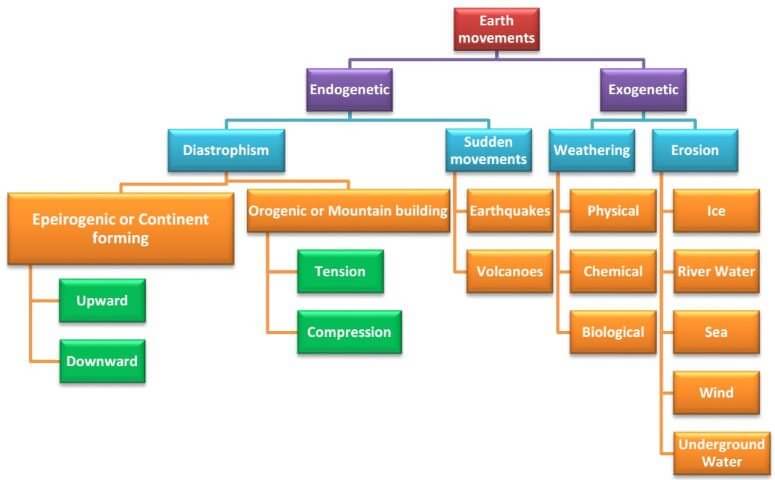GEOGRAPHY
Geomorphic Process
Any exogenic element of nature (like water, ice, wind, etc.,) capable of acquiring and transporting earth materials can be called a geomorphic agent. When these elements of nature become mobile due to gradients, they remove the materials and transport them over slopes and deposit them at lower level.
Geomorphic processes and geomorphic agents especially exogenic, unless stated separately, are one and the same. A process is a force applied on earth materials affecting the same.
An agent is a mobile medium (like running water, moving ice masses, wind, waves and currents etc.) which removes, transports and deposits earth materials. Running water, groundwater, glaciers, wind, waves and currents, etc., can be called Geomorphic Agents.
The formation and deformation of landforms on the surface of the earth are a continuous process which is due to the continuous influence of external and internal forces.
The internal and external forces causing stresses and chemical action on earth materials and bringing about changes in the configuration of the surface of the earth are known as geomorphic processes.
Mind Map to Study Geomorphic Processes/Earth Movements

Endogenic Forces
- Endogenic Forces are those internal forces which derive their strength from the earth’s interior and play a crucial role in shaping the earth crust.
- Examples – mountain building forces, continent building forces, earthquakes, volcanism etc.
- The endogenic forces are mainly land building forces.
The energy emanating from within the earth is the main force behind endogenic geomorphic processes. This energy is mostly generated by radioactivity, rotational and tidal friction and primordial heat from the origin of the earth.
Exogenic Forces
- Exogenic Forces are those forces which derive their strength from the earth’s exterior or are originated within the earth’s atmosphere.
- Examples of forces – the wind, waves, water etc.
- Examples of exogenic processes – weathering, mass movement, erosion, deposition.
- Exogenic forces are mainly land wearing forces.
Exogenic forces can take the form of weathering, erosion, and deposition. Weathering is the breaking of rocks on the earth’s surface by different agents like rivers, wind, sea waves and glaciers. Erosion is the carrying of broken rocks from one place to another by natural agents like wind, water, and glaciers.
Geomorphic Agents
Running water, groundwater, glaciers, the wind, waves, and currents, etc., can be called geomorphic agents.
Geomorphic Processes vs Geomorphic Agents
A process is a force applied on earth materials affecting the same. An agent is a mobile medium (like running water, moving ice masses, the wind, waves, and currents etc.) which removes, transports and deposits earth materials.
Earth Movements
- They are the movements in the earth’s crust caused by the endogenic or exogenic forces. These movements are also termed as Tectonic movements.
- The term ‘Tectonic’ derived from the Greek word ‘Tekton’ which means builders.
- As the word means, these movements are mainly builders and have been responsible for building up of different types of landforms.
